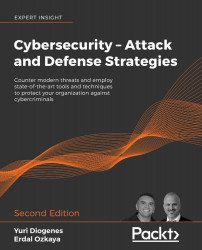Lab – Hacking Wireless Network/s via Evil Twin Attack
Evil Twin attack is a Wi-Fi access point that "pretends" to be legitimate but is set up to eavesdrop on wireless communications.
The Lab Scenario
As the following figure illustrates, the Threat Actor sets up fake access points with the same name as the "legitimate access point" and the victims are forced out of their access point and on to the Threat Actor's one:

Figure 27: A scenario where victims are focused out of their legitimate access points and on to a Threat Actor's fake access point
As a change in access point will usually alert the user, most Threat Actors wait until the "mobile" device will try to "re-authenticate" to get an IP address. And this is our lab scenario.
Step 1 – Ensure you have all required hardware and software for the "simulated attack"
These are the ingredients of our attack:



